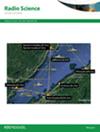MCSEM induction-polarization anomaly identification based on two-scale feature extraction network and XGBoost
IF 1.5
4区 地球科学
Q3 ASTRONOMY & ASTROPHYSICS
引用次数: 0
Abstract
Due to the presence of induced polarization effect in subsea reservoirs, marine controlled-source electromagnetic (MCSEM) data contain induction response and polarization response. The traditional magnitude versus offset (MVO) curve makes it difficult to manually identify the induction-polarization anomalies contaminated by noise, which leads to the reduction of anomaly resolution and affects the accuracy of data interpretation. Machine learning models possess strong feature extraction and classification ability, which can obtain probabilistic anomaly classification results. Therefore, this study proposes an induction-polarization anomaly identification method based on a two-scale feature extraction network (TFEN) combined with XGBoost algorithm. First, MCSEM induction-polarization theoretical data are calculated using the Cole-Cole model, with random noise added to simulate noisy field data. Then, to effectively fuse muli-scale features while maintaining computational efficiency, a TFEN model is constructed. This model employs long short-term memory and dilated convolution to automatically extract the two-scale nonlinear features from induction-polarization data, followed by feature fusion. Finally, the identification of MCSEM induction-polarization data is realized using the XGBoost. The results show that TFEN-XGBoost achieves the highest anomaly identification accuracy compared with Random Forest, TFEN alone, and XGBoost alone. When the MVO curve fails to distinguish induction-polarization anomalies, the TFEN-XGBoost model achieves a recognition accuracy of 95.89% on theoretical data and 88.93% on noisy data sets. This demonstrates that the combined TFEN-XGBoost model can effectively identify induction-polarization anomalies, providing important technical support for oil resource exploration based on MCSEM.基于双尺度特征提取网络和XGBoost的MCSEM感应极化异常识别
由于海底储层存在诱导极化效应,海洋可控源电磁(MCSEM)数据包含感应响应和极化响应。传统的MVO (magnitude - offset)曲线难以人工识别受噪声污染的感应极化异常,导致异常分辨率降低,影响数据解释精度。机器学习模型具有较强的特征提取和分类能力,可以获得概率异常分类结果。因此,本研究提出了一种基于双尺度特征提取网络(TFEN)与XGBoost算法相结合的感应极化异常识别方法。首先,采用Cole-Cole模型计算MCSEM感应极化理论数据,并加入随机噪声模拟噪声场数据。然后,为了在保持计算效率的同时有效融合多尺度特征,构建了TFEN模型。该模型采用长短期记忆和扩展卷积技术,从感应极化数据中自动提取两尺度非线性特征,然后进行特征融合。最后,利用XGBoost实现了MCSEM感应极化数据的识别。结果表明,与Random Forest、TFEN单独和XGBoost单独相比,TFEN-XGBoost的异常识别准确率最高。当MVO曲线无法区分感应极化异常时,TFEN-XGBoost模型对理论数据的识别准确率为95.89%,对噪声数据集的识别准确率为88.93%。说明TFEN-XGBoost联合模型能够有效识别感应极化异常,为基于MCSEM的油气资源勘探提供了重要的技术支撑。
本文章由计算机程序翻译,如有差异,请以英文原文为准。
求助全文
约1分钟内获得全文
求助全文
来源期刊

Radio Science
工程技术-地球化学与地球物理
CiteScore
3.30
自引率
12.50%
发文量
112
审稿时长
1 months
期刊介绍:
Radio Science (RDS) publishes original scientific contributions on radio-frequency electromagnetic-propagation and its applications. Contributions covering measurement, modelling, prediction and forecasting techniques pertinent to fields and waves - including antennas, signals and systems, the terrestrial and space environment and radio propagation problems in radio astronomy - are welcome. Contributions may address propagation through, interaction with, and remote sensing of structures, geophysical media, plasmas, and materials, as well as the application of radio frequency electromagnetic techniques to remote sensing of the Earth and other bodies in the solar system.
 求助内容:
求助内容: 应助结果提醒方式:
应助结果提醒方式:


